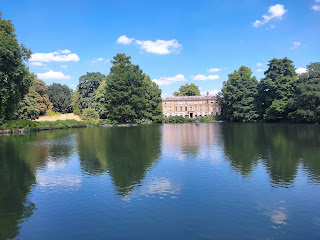Phew, what a scorcher!
Monday was hot hot hot! I was using up some leave from work and had decided to spend the day in the lovely, relaxing Kew Gardens. Ostensibly, to see The Power of Trees exhibition but perhaps more because it's quite simply a pleasant place to spend an afternoon. I visited the palm houses, looked at trees and plants, had a disappointing ice cream, and even fell asleep in the shade for a while.
But 'business' first. The Power of Trees is a selection of botanical art that is intended to offer a thoughtful reflection on trees - and their power. Although to be honest you can get that better just by walking round the gardens themselves. Or looking at a tree. Pretty much anywhere.
Phansakdi Chakkaphak - Japanese Pine Cone (2017)
That's not to say the art isn't good. Some of it is. Some of it not so much. I liked Phansakdi Chakkaphak's pine cones (I just like pine cones, who doesn't?) and Ingrid Finna's dense tropical looking snake branch spruce. Arundhati Vartak's work was pretty and decorative too. The 'cannonballs' in her cannonball tree named so because that tree's fruit resemble cannonballs.
Ingrid Finnan - Snake Branch Spruce (2018)
I learnt that the gingko biloba (originating in China) is one of the oldest living tree species in the world with fossils dating back over two hundred million years and I also found out the the magnolia is pretty old too. That dates back over one hundred million years and is the oldest known tree to bear flowers.
You can learn a lot at The Power of Trees. How forests cover about a third of Earth's surface and store roughly 45% of the planet's carbon. Most humans living in extreme poverty rely on forests for food, firewood, and building materials and we ALL rely on trees and forests to keep us alive.There are no trees on Mars which is something hopefully Elon Musk has overlooked.
80% of the world's amphibians, 75% of birds, and 68% of mammals make their homes in forests. It's no wonder we find them such fascinating, awesome, and, sometimes, frightening, places. I love to visit forests but most people don't want to get stuck in one at night where every little sound has one wondering what sort of creature made that noise!
Brigid Edwards - Magnolia Leaves and Fruit
Kimyo Maruyama - Japanese Black Pine (2005)
Susan Conroy - Cuprocyparis leylandii Leyland cypress
Redwood trees are the tallest living things on earth and some are over one thousand years old. I remember visiting California and being very impressed with them. Resilient! As our gingkos. Some even survived the atomic bomb dropped on Hiroshima in August 1945.
The Bedgebury National Pinetum is located in Kent and has a celebrated collection of conifers including some three hundred year old English oak trees and some that date back to an ancient forest in the area once owned by a Beresford family who introduced exotic tree species to the forest - and to Britain - and thus changed the face of the entire landscape. It's always worth remembering that though trees are natural, the decisions of which ones to keep and which ones to fell - and where to plant new trees - is made by us humans. There are elements of the man-made even in the natural environment.
Elja-Lilsa Ahtila's Vaaksuora-Horizontal is a full scale portrait of a living spruce tree which is being shown, for some reason, in a horizontal projection in Kew. The actual tree is in a park in Ahtila's home country of Finland. When you stand in the gallery looking at it you can hear the sounds of birds and the sound of the leaves blowing in the wind. Which, to be honest, you can do for real when you step outside the gallery.
Elja-Lilsa Ahtila - Vaaksuora-Horizontal (2011)
Elja-Lilsa Ahtila - Vaaksuora-Horizontal (2011)
Annie (Ann) Farrer - Juniperus communis (1990s)
When the exhibition isn't dwelling on spruce trees (or pine cones) it's pondering conifers. Ahtila has selected some favourites from Kew's collection for the show and then there's some stuff about trees and their role in art history. They've served as pure landscape detail, as national identifiers, metaphors, and other symbols. Van Gogh, Caspar David Friedrich, Constanble, and even Mondrian all enjoyed a good tree and all painted them.
Here there are realistic depictions of trees alongside faux-naif renderings and though they're all rather good none of them could, in truth, compete with nature itself so it wasn't long before I left the gallery and went to explore the gardens proper. I haven't written about that but there are lots of nice photos so you can envy my nice day in Kew Gardens. You could always join me next time.


















































No comments:
Post a Comment